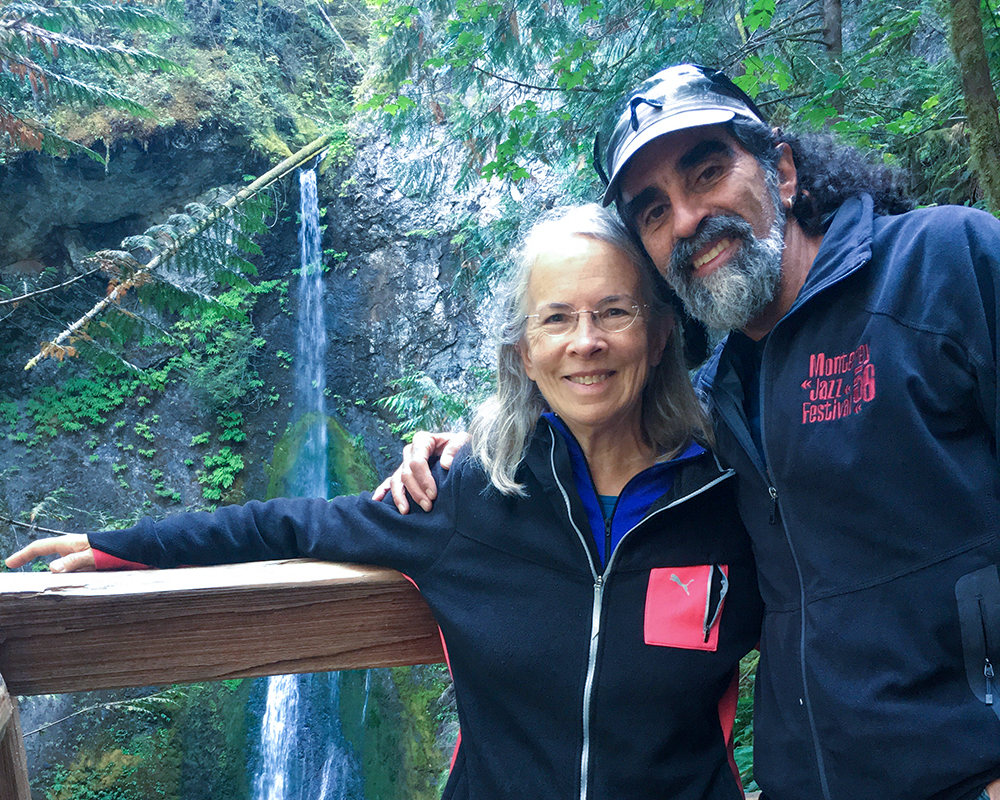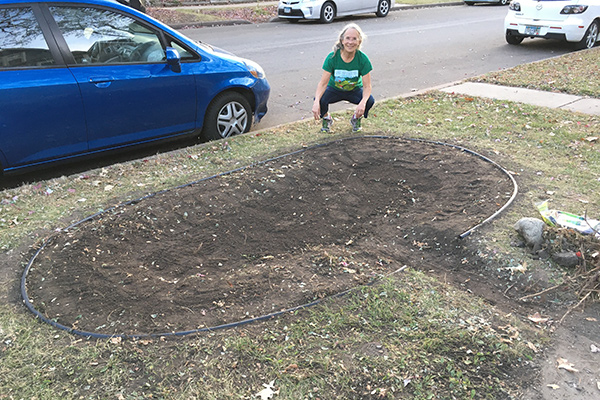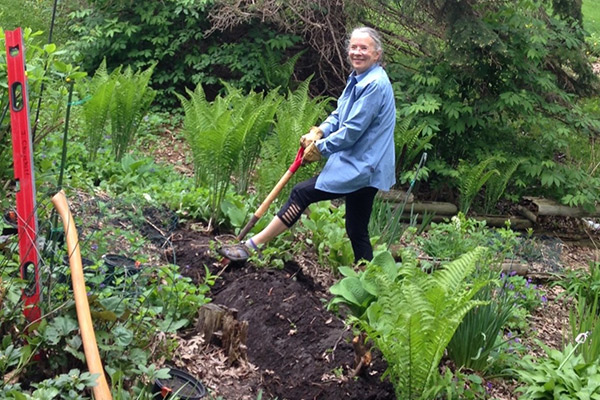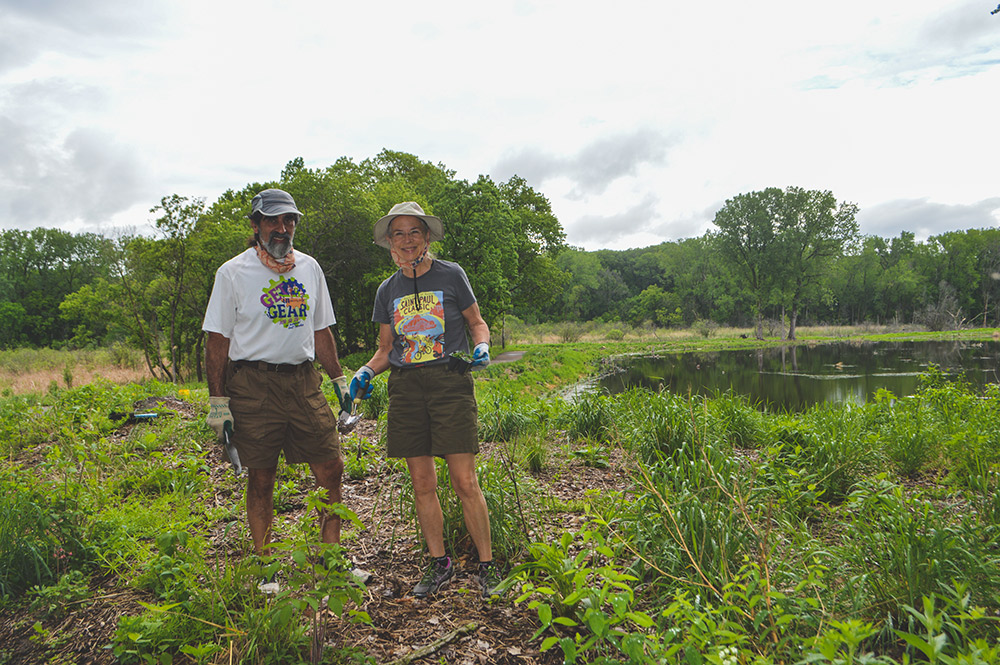
by Chris Kunz
When I retired from my career as a law professor at William Mitchell, I found myself drawn back to my bachelor’s degree in biology. When I was an undergrad at the University of Wisconsin (UW), my interest was in molecular biology—the new discoveries concerning DNA and RNA, the molecules that power life. I took a course on ecology, but it didn’t capture my 20-year-old heart. By the time I retired, that had changed. I was looking for volunteer opportunities to improve local ecology.
Finding the Minnesota Water Steward program
But where to look? When I was at UW, I rowed on the women’s crew team and took an advanced canoeing course. I’ve canoed the BWCA, the Quetico, and Minnehaha Creek across the cities many times, from Gray’s Bay to the falls. So water was a likely partner. I considered joining the Citizen’s Advisory Board for Minnehaha Creek Watershed District, but I had a conflict with the meeting time.
Then it dawned on me—what watershed district do I live in? Fortunately, an easy online search told me that I live in Capitol Region Watershed District (CRWD). CRWD’s website featured a new volunteer program, now called “Minnesota Water Stewards” (MWS). A yearlong training class was starting soon, run by Freshwater. I jumped on it in fall of 2016.
Freshwater’s online training materials and weekly classes were a lively blend of disciplines—ecological networks, hydrological cycle, city management of stormwater and wastewater, agricultural practices contributing to excess stormwater and pollution, community organizing techniques, and so much more.
Freshwater’s online training materials and weekly classes were a lively blend of disciplines—ecological networks, hydrological cycle, city management of stormwater and wastewater, agricultural practices contributing to excess stormwater and pollution, community organizing techniques, and so much more. We learned how to construct and maintain rain gardens, bioswales, rain barrels, and other stormwater retention techniques. Our classes also featured guest experts and field trips.
As I worked my way through Freshwater’s course, I realized that the MWS program was melding my biology major with my gardening roots. When I grew up on a city lot in Indianapolis, my parents grew apples, pecans, plums, persimmons, pawpaws, grapes, raspberries, asparagus, and lots of annual crops and flowers. They both eventually became Master Gardeners. Each daughter had a garden, and I’ve been gardening ever since.
Wading into stormwater projects
For my capstone project in spring 2017, I partnered with my husband and neighbors to construct two adjacent rain gardens. I also gave a tour of five neighborhood rain gardens, but none of the attendees seemed to be interested in a new rain garden. CRWD’s advisor of the Water Stewards, Lindsay Schwantes, said, “Be patient.” She was right—by 2021, each attendee had one or two rain gardens. The six rain gardens on our block now capture 46,886 gallons of stormwater in a typical year! In turn, those neighbors are persuading their neighbors to create rain gardens. The underlying ecology of our neighborhood, two blocks from the Mississippi River bluffs, is slowly changing, household by household. That’s the very essence of grassroots organic change.

Since my MWS certification in 2017, my fellow Stewards have been valuable partners as we inspected hundreds of boulevard rain gardens, rehabilitated the rain garden at Linwood Community Center, rescued two homeowners from 8-foot-tall plants that took over boulevard rain gardens, taught kids about the tiny critters in the water and weeds at Como Lake, joined Master Gardeners to staff a table at Minneapolis Monarch Festival at Lake Nokomis, guided a tour for Ramsey County Master Gardeners at a house with many stormwater retention systems, and helped to construct and maintain countless residential rain gardens.
My MWS class was a blend from CRWD and Ramsey-Washington Country Watershed District (RWCWD), and those connections have been valuable. I’ve worked on projects with RWCWD staff and Minnesota Water Stewards—two rain gardens at First Covenant Church, the pollinator teaching garden at Farnsworth Academy, several planting seasons at Snail Lake, and an Adopt-A-Drain campaign near Lake Phalen. In turn, they’ve contributed volunteer hours at the CRWD booth at Highland Fest and donated a whole backyard of perennials to a new rain garden on our block. As I continued to volunteer over 100 hours per year, I was stunned and honored to be awarded CRWD’s Citizen of the Year in 2021.
Branching out to wider opportunities
One of my friends—an avid hosta gardener in Apple Valley—had two overflowing rain barrels. I calculated that she really needed eight, which would be way too many for her patio. Her backyard sloped too steeply for a rain garden, so we installed an S-curve French drain that snaked down the slope with 3-foot-deep rock pits at each turn. It worked!
As Water Stewards, we’re on the front lines of changing the environment working on rain gardens, French drains, rain barrels, pollinator gardens and lawns, sidewalk salt reduction, and lawn sprinkler reduction.
The project was so successful that she convinced the American Hosta Society to let me write an article about it in their quarterly Hosta Journal. My four-page full-color article was published last spring, with an accompanying note from the journal’s scientific editor, emphasizing the importance of these rainwater retention techniques for hosta gardeners—and for the planet.

I took Freshwater’s training for Water Conservation Advisors to learn how to help homeowners decrease lawn watering and not waste drinking water. Other programs on “Stop Over-Salting” have enabled me and my fellow Water Stewards to help property owners moderate their salt use. Yet another program taught us about pollinator lawns. These training opportunities tie well into rain gardens and other stormwater retention methods, helping decrease water runoff, improve water quality, and enhance pollinator habitat. My husband and I feel that our donations to Freshwater Society play an important role in sustaining these training programs, funding research and conferences, tackling a wide range of projects, and thereby improving Minnesota’s freshwater resources. It is money well spent.
Our donations to Freshwater Society play an important role in sustaining these training programs, funding research and conferences, tackling a wide range of projects, and thereby improving Minnesota’s freshwater resources. It is money well spent.
Thanks to this training, I now look at the urban landscape with new eyes, spotting stormwater retention projects and analyzing places where they’re needed or could be improved. As Water Stewards, we’re on the front lines of changing the environment working on rain gardens, French drains, rain barrels, pollinator gardens and lawns, sidewalk salt reduction, and lawn sprinkler reduction. While these changes begin in the neighborhood, they help to improve the entire Mississippi River watershed and assist pollinators and other wildlife beyond that watershed.
For that, I want to wholeheartedly thank the Freshwater Society and Capitol Region Watershed District for training and supporting this amazing cadre of Minnesota Water Stewards. And I want to urge you and others to consider this rich volunteer opportunity.
